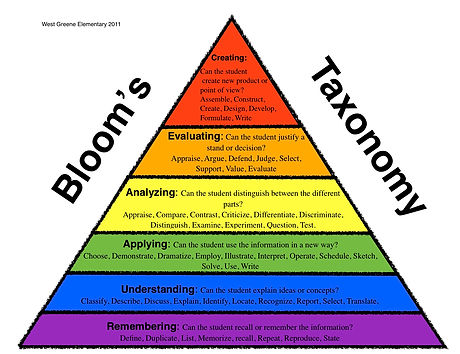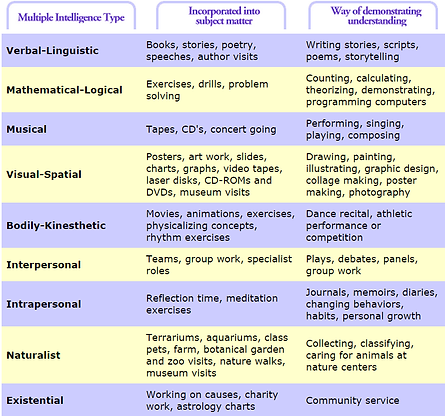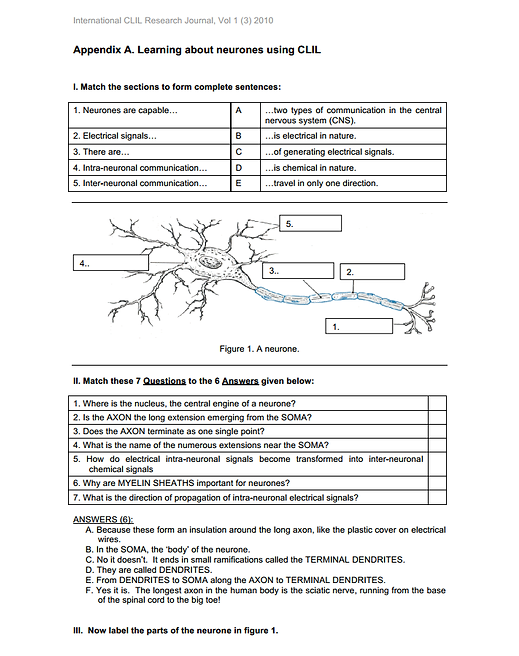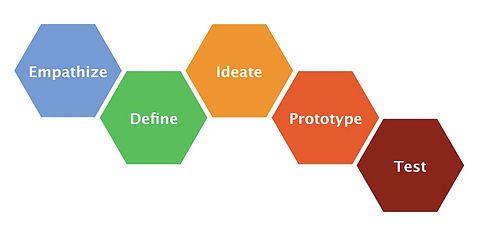Elena Perea Úbeda-Portugués

Cognition

Meaningful learning
Meaningful learning is opposed to rote learning and refers to a learning way where the new knowledge to acquire is related with previous knowledges (Ausubel 2000). Within the cognitive theory of learning, based on the theory of human information processing, the 3 core processes of learning are: how knowledge is developed; how new knowledge is integrated into an existing cognitive system; and how knowledge becomes automatic.
There are many things that we can do in ouw classrooms to promote meaninful learning. Here you have some documents about Inquiry-Based and Cooperative Learning teaching and using technologies to make learning meaningful.
Cognition is the set of all mental abilities and processes related to knowledge: attention, memory & working memory, judgement & evaluation, reasoning & "computation", problem solving & decision making, comprehension & production of language, etc. Cognition is by humans conscious and unconscious, concrete or abstract, as well as intuitive (like knowledge of a language) and conceptual (like a model of a language). Cognitive processes use existing knowledge and generate new knowledge.
The zone of proximal development (ZPD) has been defined as "the distance between the actual developmental level as determined by independent problem solving and the level of potential development as determined through problem solving under adult guidance, or in collaboration with more capable peers" (Vygotsky, 1978, p. 86).
Lev Vygotsky views interaction with peers as an effective way of developing skills and strategies. He suggests that teachers use cooperative learning exercises where less competent children develop with help from more skillful peers - within the zone of proximal development.
Vygotsky believed that when a student is in the ZPD for a particular task, providing the appropriate assistance will give the student enough of a "boost" to achieve the task.
The ZPD has become synonymous in the literature with the term scaffolding. However, it is important to note that Vygotsky never used this term in his writing, and it was introduced by Wood et al. (1976). Once the student, with the benefit of scaffolding, masters the task, the scaffolding can then be removed and the student will then be able to complete the task again on his own.
Wood et al. (1976, p. 90) offer the following definition of scaffolding: 'Those elements of the task that are initially beyond the learner’s capacity, thus permitting him to concentrate upon and complete only those elements that are within his range of competence'.

Creativity

Scaffolding
Pedagogical principles
Pedagogical principles are essential conditions for curriculum implementation, teaching practise, achieving learning and improvement of the quatily of education.
Despite growing interest in creativity and its application in classrooms, solutions for harnessing creativity have been scarce. Canvas Network offers a course on the five habits of highly creative teachers. They identify these five habits for teachers but they can easily be used in students to foster creativity. Click on the image if you want to read more about it.
Ken Robinson’s renowned TED talk, “How Schools Kill Creativity,” has had 27 million views. To date, it is the most-watched TED talk of all time. Sir Kenneth Robinson (born 4 March 1950) is an English author, speaker and international advisor on education in the arts to government, non-profits, education and arts bodies. He was Director of the Arts in Schools Project (1985–89), Professor of Arts Education at the University of Warwick (1989–2001), and was knighted in 2003 for services to art.
Integrated Inquiry planning model (Kath Murdoch)
If you want to read more about this model for lesson planing there is some information in this same website here. I am going to give you a few documents useful for using the model of lesson plan in your practice.
Inquiry self assessment
Sharing learning objectives
I never share the lesson objectives with my students, perhaps because lately I have been working with younger children and it never seemed important to me. The purpose for doing so would be so that children have an explicit awareness of what they are going to learn. Not just learning but thinking about learning. I agree that this can be useful but definitely not when done the obvious way: We are going to learn this today. It seems the most effective way would be to begin with a starter activity that engages students, analyse their needs and can in itself set the learning objectives and then check during the class and during the plenary with the students to make sure they still have their eye on the objectives and that they can see they are making progress.
Starter and plenaries in the classroom
Effective teachers make good use of starters and plenaries in the context of interactive whole-class teaching to engage all pupils in constructive deep learning. When pupils are merely reproducing or memorising given facts and information; accepting ideas and information passively; not being required to look for principles or patterns or to reflect on goals and progress – then they are only engaged in surface learning.
NLP - Different perspectives
In this NLP technique you mentally review (or preview) a situation from a number of different standpoints in order to enrich your appreciation of what is involved. There are three main perceptual positions: first, second and third position. These involve seeing things from our own perspective (first), from another person in the situation (second or other), and then from a detached viewpoint (third or observer).
-
First position is your natural perspective, where you’re fully aware of what you think and feel regardless of those around you. This is the place that clients find most familiar. They’ve come to coaching because they already have an awareness of their own perspective and the problems they face.
-
Second position is about imagining what it’s like to be another person. Some people are very good at considering others’ needs and concerns; for a more self-focused client, imagining second position is a completely alien notion.
-
Third position is an independent position where you act as a detached observer noticing what’s happening in the relationship between two other people. Good coaches naturally step into this impartial role. In coaching, encourage the client to take this position in order to gain an impartial insight into a situation, particularly to view a relationship the client has with another person.
Using this technique:
-
Improves your understanding of other people.
-
Enables you to think more flexibly and creatively.
-
Provides an opportunity to stand back and consider issues
dispassionately.
-
Helps you appreciate the influence of your verbal and non-verbal
behaviour on others, and the influence of their behaviour on you.
4 C's of CLIL
A successful starter:
-
Is an activity in its own right
-
Is linked to the rest of the lesson
-
Has a clear purpose
-
Engages all pupils
-
Establishes pace
-
Provides challenge
A successful plenary:
-
Draws together the learning of the group
-
Summarises the learning so far
-
Consolidates and extends learning
-
Directs pupils to the next phase of learning
-
Highlights what has been learned and how
-
Determine the next steps in learning
Here you have some examples of starters and plenaries:

What is CLIL
David Marsh on CLIL
In developing the rationale for introducing CLIL into the curriculum it may be helpful to consider the benefits to teachers and learners in relation to four specific dimensions: These four dimensions (4 Cs) form a conceptual framework (Coyle 2005; revisited Coyle, Holmes, King 2008), which connects content, cognition, communication and culture. Culture
and intercultural understanding lie at the core of the conceptual framework, offering the key to deeper learning and promoting social cohesion.
-
Content: integrating content from across the curriculum through high quality language interaction.
-
Cognition: engaging learners through higher order thinking and knowledge processing.
-
Communication: using language to learn and mediate ideas, thoughts and values.
-
Culture: interpreting and understanding the significance of content and language and their contribution to identity and citizenship.
Now you can find a puzzle with the CLIL essentials as well as few useful publications about CLIL.
Skinny & fat questions
In this strand we have talked about several actions that will help to make learning more meaningful.
Multiple intelligences
HOTS & LOTS
Bloom's Taxonomy
Below are examples of two types of questions. “Skinny” questions require lower level thinking and are the type to ask when you want simple recall of facts and information. These questions require simple one or two word answers. “FAT” questions require higher order thinking skills, and are reminiscent of Bloom’s Taxonomy type of questioning, and require more detailed answers.
Skinny Questions:
-
will get only one or two-word answers
-
yes and no questions
-
don’t ask about important information
-
ask only about basic facts
Fat Questions:
-
will be answered with lots of information
-
get at the main ideas of the story or book
-
may be about feelings
-
ask about opinions
-
may be to clarify things you didn’t understand in the reading
-
ask if any one has ever had similar experiences
-
make predictions
-
explain why or how
-
make connections or comparisons
Examples:
“What if...” “Why did...”
“How did...” “What would happen if...”
“What caused...” “What might...”
“How would you feel if...”
“What character traits describe ______?
Explain”
“Why do you think...” “Why is...”
Bloom's taxonomy is a way of distinguishing the fundamental questions within the education system. It is named after Benjamin Bloom, who chaired the committee of educators that devised the taxonomy. He also edited the first volume of the standard text, Taxonomy of Educational Objectives: The Classification of Educational Goals.
Bloom's taxonomy refers to a classification of the different objectives that educators set for students (learning objectives). It divides educational objectives into three "domains": cognitive, affective, and psychomotor (sometimes loosely described as "knowing/head", "feeling/heart" and "doing/hands" respectively). Within the domains, learning at the higher levels is dependent on having attained prerequisite knowledge and skills at lower levels. A goal of Bloom's taxonomy is to motivate educators to focus on all three domains, creating a more holistic form of education.
Bloom's taxonomy is considered to be a foundational and essential element within the education community. Incorporating Bloom’s Taxonomy into lesson objectives will enable both you and your learners to visualize the ‘bigger picture.’ More importantly, we as teachers can use the cognitive domain of the Taxonomy to realize what exactly we are asking learners to do in class.
There are several benefits to using Bloom’s Taxonomy to help you write objectives:
-
You will have more insight into the relative ease or difficulty of all the tasks you are setting in terms of cognitive load.
-
You will have better understanding of how course books are put together and how the difficulty of tasks progresses across a unit of study.
-
You will be able to recognize whether or not you are setting too many exercises that are either cognitively easy or demanding.
-
You will more understanding of how to set up a progression of activities so that the cognitive load increases appropriately.
Let’s look at each level and see what it means in terms of developing an objective.
1. Remembering
At the most basic level of the framework, learners are asked to recall information. Defining terms and correctly identifying the meaning of certain words are typical course book tasks that represent this level.
Example objective: ‘Learners will be able to match vocabulary items to the correct definitions.’
2. Understanding
At this level, learners are asked typically required to interpret facts and compare and contrast newly learned information. True or false activities and reading comprehension questions are at the understanding level.
Example objective: ‘Learners will be able to answer comprehension questions for a reading text.’
3. Applying
At the applying level, learners apply concepts and techniques that they learned in class to authentic situations. A typical task at this level would be to write a paragraph based on a model presented in the course book.
Example objective: ‘Learners will be able to write a paragraph based on information given in a table.’
4. Analyzing
At the next level, learners are required to uncover patterns and discover meaning by differentiating information. Grammar boxes that require learners to deduce the rules are examples of activities at this level.
Example objective: ‘Learners will be able to deduce the grammar rules for using who and whose in relative clauses.’
5. Evaluating
At the evaluating knowledge level, teachers are starting to really challenge learners to build up high-level critical thinking skills. Tasks might include, for instance, making choices about a text and providing evidence for these choices.
Example objective: ‘Learners will be able to identify the author’s stance and provide evidence to support this viewpoint.’
6. Creating
At the highest level of Bloom’s Taxonomy, learners are required to create some kind of tangible product. We typically see such activities at the end of a course book unit, in which all of the input leads to the production of a poster or a set of rules, or some such interpretation of what has been learned.
Example objective: ‘Learners will be able to create a PowerPoint presentation summarizing what they have learned about today’s topic.’
Bloom's taxonomy posters for the classroom
Bloom's taxonomy posters for the classroom


Higher-order thinking, known as higher order thinking skills (HOTS), is a concept of education reform based on learning taxonomies (such as Bloom's Taxonomy). The idea is that some types of learning require more cognitive processing than others, but also have more generalized benefits. In Bloom's taxonomy, for example, skills involving analysis, evaluation and creation are thought to be of a higher order, requiring different learning and teaching methods, than the learning of facts and concepts. Higher order thinking involves the learning of complex judgemental skills such as critical thinking and problem solving. Higher order thinking is more difficult to learn or teach but also more valuable because such skills are more likely to be usable in novel situations (i.e., situations other than those in which the skill was learned).
HOTS question fans for reading comprenhension
A website with all the information about thinking skills
The theory of multiple intelligences is a theory of intelligence that differentiates it into specific (primarily sensory) "modalities", rather than seeing intelligence as dominated by a single general ability. This model was proposed by Howard Gardner in his 1983 book Frames of Mind: The Theory of Multiple Intelligences.

Classroom activities frequently activate and utilize more than one of the multiple intelligences. Now consider how you would add to and interpret the items on the following list:
-
Group discussion - Verbal-Linguistic; Interpersonal
-
Journal writing - Intrapersonal; Verbal/Linguistic
-
Choreography - Musical-Rhythmic; Verbal-Linguistic; Interpersonal
-
Constructing timelines - Logical-Mathematical; Visual-Spatial
-
Putting on a play - Musical-Rhythmic; Verbal/Linguistic; Interpersonal; Visual-Spatial
-
Making a video - Logical-Mathematical, Musical-Rhythmic; Verbal/Linguistic; Interpersonal; Visual-Spatial
-
Writing a report or essay - Verbal-Linguistic
-
Making graphs - Logical-Mathematical; Visual-Spatial
-
Designing posters - Verbal-Linguistic, Visual-Spatial
-
Communicating with peers or experts online - Verbal-Linguistic; Interpersonal
-
Hands-on experimentation - Kinesthetic; Logical/Mathematical
-
Composing a song - Musical/Rhythmic; Verbal-Linguistic
-
Building a model or 3-D displays - Kinesthetic; Logical-Mathematical
-
Mind map: All of them bt musical.

Howard Gardner on MI
Scaffolding oral interaction in a CLIL context

Conventional foreign language teaching is usually based on controlled input and on practising the language. However, when teaching a subject through a foreign language, the methodology differs in some ways. As the subject dictates the language needs, we have to analyse the language our pupils will require in order for them to understand and express their understanding of the content area and make sure we give them the necessary linguistic support to do this. This means carefully planning the language we are going to use when delivering the content, plus the language (in terms of lexis, language chunks and structures) that pupils will need to be able to speak and write about what they’ve learnt. As well as this linguistic support, we need to help pupils with cognitive functions (ie the thinking skills they require in order to understand the concepts) and the study skills necessary to do this.
It is also clear that in CLIL we have to include more strategies to support understanding of both language and content. We need to give them short bits of comprehensible input supported by visuals such as pictures, charts and diagrams displayed around the classroom; overhead projectors and PowerPoint presentations will help as well. There is a clear need to begin any topic by drawing on learners’ previous knowledge. This gives us a starting point familiar to everyone and in doing so we can begin to input key vocabulary and language chunks. The fact that children can see at a glance (through the visual materials) the main expressions they need means they have at hand the language they need to express the knowledge they have.
Here you have an activity where both language and content are scaffolded.
Diferentiation


Individualisation and differentiation are successful ways of dealing with the different capacities of pupils in the classroom. The teacher has to be aware that he/she is teaching individual students as well as content. Students differ in how they learn so the teacher has to be actively responsive to those differences.
Some may argue against students with SEN learning MFL on the grounds of relevance and difficulty. On the first point, we live in a world where most people, including those with SEN, speak at least two languages. Greater international mobility for business or pleasure brings more people than ever into contact with speakers of languages other than their own. Many different home languages are spoken within countries themselves nowaways because of inmigration.
Following these same steps from the Design Thinking Action Lab from Standford University we can cater for SEN.
-
Empathize: Investigate about your student background and gather as much useful information as you can from his/her doctors, specialist SEN teachers as school, previous teachers, family and other students.
-
Define: Take the problems as opportunities to innovate. Tap into what yor students likes and does best to help them learn. Multiple intelligences are a great help.
-
Ideate: Devise possible solutions. You can use strategies from students with different backgrounds.
-
Prototype: Follow a process to implement the solutions. Think about what classroom interactions are the best for them.
-
Test: Assess the process and the student. Don't forget to change the type of assessment according to your student's needs.
Including pupils with SEN and/or disabilities in primary modern foreign languages
Teaching and Learning with Beadle - Focus on the Lesson Objectives
Collaborative learning is a method of teaching and learning in which students team together to explore a significant question or create a meaningful project. A group of students discussing a lecture or students from different schools working together over the Internet on a shared assignment are both examples of collaborative learning.
Cooperative learning vs collaborative learning
Cooperative learning is a specific kind of collaborative learning. In cooperative learning, students work together in small groups on a structured activity. They are individually accountable for their work, and the work of the group as a whole is also assessed. Cooperative groups work face-to-face and learn to work as a team.
The terms collaborative learning and cooperative learning sometimes are used interchangeably. This is reasonable, as both favor small-group active student participation over passive, lecture-based teaching and each require a specific task to be completed. Each strategy inherently supports a discovery based approach to learning. The two methods assign various group roles though collaborative learning can have fewer roles assigned. In both situations, student members are required to possess group skills though cooperative learning may include this as a instructional goal. Each plan comes with a framework upon which the group's activity resides, but cooperative learning is usually more structurally defined than collaborative learning (Cooper and Robinson, 1997; Smith and MacGregor, 1992; Rockwood, 1995a, 1995b).
The concept of collaborative learning, the grouping and pairing of students for the purpose of achieving an academic goal, has been widely researched and advocated throughout the professional literature. The students are responsible for one another's learning as well as their own. Thus, the success of one student helps other students to be successful.
Proponents of collaborative learning claim that the active exchange of ideas within small groups not only increases interest among the participants but also promotes critical thinking. According to Johnson and Johnson (1986), there is persuasive evidence that cooperative teams achieve at higher levels of thought and retain information longer than students who work quietly as individuals. The shared learning gives students an opportunity to engage in discussion, take responsibility for their own learning, and thus become critical thinkers (Totten, Sills, Digby, & Russ, 1991)
NLP Activities for the classroom
Sometimes, as teachers, we ran out of ideas. Finding inspiration will surprise your students with something they haven't experienced before but it will also make you feel that you are improving as a teacher and will get you out of a "teaching rut". My favourite place to find inspiration is definately Pinterest. I can search for what I want of I can scroll through the suggestions based on my pins. It is also a great way to keep all those ideas organised so you can look for them and share them with your colleages. I invite you to check out mine and hopefully you will find something amazing for your lessons.












